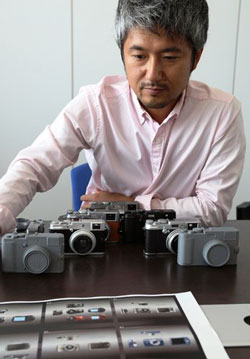Interesting article by the New York Times on Fujifilm finding its niche as digital camera sales sputter: old-style cameras that mask a high-tech core. For certain work you can’t replace a D800 or 5D Mark III. But it’s just not that much fun. Et voilà the state-of-the-art and retro-looking Fujifilm X series, designed by Masazumi Imai — and further below we talk about Bublcam, a 360° camera and software technology that shares everything around you through spherical photos and videos.
The X series blends Fujifilm’s digital technology with retro aesthetics reminiscent of cameras from 60 or 70 years ago, says the Times. At a time when sales of other cameras are slumping, the X series — with its latest addition the X-E2 — is selling briskly.
Fujifilm still makes film, but it now accounts for less than 1% of the company’s sales. The entire imaging solutions division, which includes the company’s cameras, generates a mere 13% of revenue. Most revenue comes from businesses like pharmaceuticals, medical equipment and office machines, in which Fujifilm has a partnership with Xerox.

The X series is a different response. In its most recent quarterly earnings announcement Fujifilm said sales of “such high-end models as the X series proceeded smoothly.” 700,000 X cameras sold, claims Fujifilm.
Interestingly, the article says the series’ name X refers to the fact that these mirrorless cameras do away with the internal mirror that, in reflex cameras, allows the user to compose through the lens while the shutter is closed.
The concept is not entirely new. The venerable Leica rangefinder, which predates the SLR, is technically a mirrorless camera — even though it uses mirrors in the viewfinder mechanism.
While many mirrorless cameras simply look like smaller substitutes for DSLRs, Fujifilm took a different approach in the X series. With boxy, rectangular bodies and straight, cylindrical lenses, they resemble classic Leicas.
Explains Hiroshi Kawahara, a marketing manager in the Fujifilm camera division:
Because of our heritage in film, picture quality was important, but picture quality is difficult to explain, so we needed something else.
According to Masazumi Imai, the chief designer of the X series, the company interviewed professional photographers about their preferences on everything from the pebbled plastic that covers parts of the cameras to the color of the paint on the bodies. Almost a dozen different shades of silver were considered.
The goal was to give the cameras a certain gravitas, so professionals would give them a try.
Mr. Imai:
When we were little, when we went into our father’s room or our grandfather’s room, there was an important-looking camera on the shelf, and we were told not to touch it because it was valuable. We wanted to create that kind of look and feel.
Moving on, you might have heard of a Kickstarter project called Bublcam. The amazing thing is not only the 360° camera itself. The way how new, forward-looking ideas get funding is not less exciting.
Shortly after launch of the 360° HD video camera on Kickstarter, Bublcam raised $100,000. They’re now approaching C$300,000.
The Bublcam has four lenses and shoots photos and videos with zero blindspots. A built-in Wi-Fi unit allows anyone and everyone to stream live 360° video over the Web. That means anyone with an app can control what they can see on the Bublcam end… panning up, down and all around.
If you absolutely want the 22MB Bublcam press kit with photos and more information, download it here.


